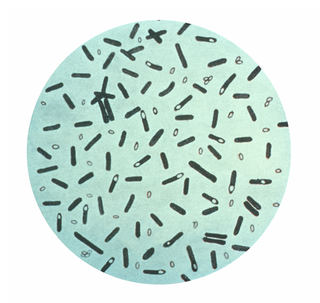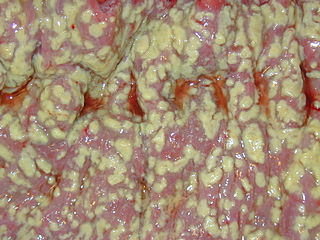
Clostridium is a genus of anaerobic, Gram-positive bacteria. Species of Clostridium inhabit soils and the intestinal tract of animals, including humans. This genus includes several significant human pathogens, including the causative agents of botulism and tetanus. It also formerly included an important cause of diarrhea, Clostridioides difficile, which was reclassified into the Clostridioides genus in 2016.

Clostridioides difficile infection , also known as Clostridium difficile infection, is a symptomatic infection due to the spore-forming bacterium Clostridioides difficile. Symptoms include watery diarrhea, fever, nausea, and abdominal pain. It makes up about 20% of cases of antibiotic-associated diarrhea. Antibiotics can contribute to detrimental changes in gut microbiota; specifically, they decrease short-chain fatty acid absorption which results in osmotic, or watery, diarrhea. Complications may include pseudomembranous colitis, toxic megacolon, perforation of the colon, and sepsis.

The Clostridiaceae are a family of the bacterial class Clostridia, and contain the genus Clostridium.
Oxobacter is a genus of Gram-positive obligately anaerobic rod-shaped acetogenic bacteria. The sole species in the genus is Oxobacter pfennigii, formerly known as Clostridium pfennigii. This endospore-forming microorganism catabolizes pyruvate to acetate and CO2, while sugars and amino acids are not utilized as energy sources.
Thermoanaerobacter is a genus in the phylum Bacillota (Bacteria). Members of this genus are thermophilic and anaerobic, several of them were previously described as Clostridium species and members of the now obsolete genera Acetogenium and Thermobacteroides
Thermoanaerobacter kivui is a thermophilic, anaerobic, nonspore-forming species of bacteria.
Caloramator fervidus, previously known as Clostridium fervidus, is a bacterium belonging to the Bacillota.
Caloramator, is a genus of bacteriae belonging to the Bacillota.
Filifactor villosus, previously known as Clostridium villosum, is a bacterium belonging to the Bacillota.
Filifactor, is a genus of bacteria in the family Peptostreptococcaceae.
Moorella thermoacetica, previously known as Clostridium thermoaceticum, is an acetogenic, thermophilic, strictly anaerobic, endospore-forming, bacterium belonging to the phylum Bacillota.
Moorella is a genus of bacteria belonging to the phylum Bacillota.
Moorella thermoautotrophica, previously known as Clostridium thermoautotrophicum, is a rod-shaped, endospore-forming bacterium belonging to the phylum Bacillota. It is thermophilic, strictly anaerobic and acetogenic, and was isolated from a hot spring in Yellowstone National Park USA.
Oxobacter pfennigii, previously known as Clostridium pfennigii, is a bacterium belonging to the Bacillota.
Oxalophagus oxalicus, previously known as Clostridium oxalicus, is a bacterium in the family of Paenibacillaceae.
Oxalophagus is a genus of bacteria belonging to the Bacillota. Up to now, only one species of this genus is known, Oxalophagus oxalicus
Eubacterium barkeri, previously known as Clostridium barkeri, is a bacterium belonging to the Bacillota.
Paenibacillus durus is a bacterial species belonging to the Bacillota.
Thermoanaerobacterium thermosaccharolyticum, previously known as Clostridium thermosaccharolyticum, is a bacterium belonging to the Bacillota. It is an anaerobic, motile, gram-positive bacterium.
Peptoclostridium litorale, previously known as Clostridium litorale, is a bacterium belonging to the family Peptostreptococcaceae.

